

Buy Raindrops Sensor Module - Blue + Black at Cheap Price Online. To enable volume discounts on this site, use coupon code: BULKRATE during checkout.
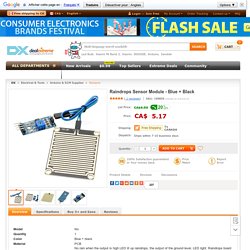
You will see a discount applied at the bottom of the shopping cart. Competitive pricing is available. Contact us for details. Allegro MicroSystems - Hall-Effect IC Application Guide. Allegro MicroSystems uses the latest integrated circuit technology in combination with the century-old Hall effect to produce Hall-effect ICs.
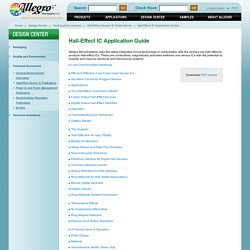
These are contactless, magnetically activated switches and sensor ICs with the potential to simplify and improve electrical and mechanical systems. Download PDF version. Untitled. Designed in conjunction with Grand Idea Studio, the Parallax Laser Range Finder (LRF) Module is a distance-measuring instrument that uses laser technology to calculate the distance to a targeted object.
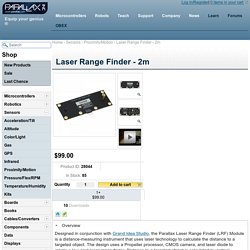
The design uses a Propeller processor, CMOS camera, and laser diode to create a low-cost laser range finder. Distance to a targeted object is calculated by optical triangulation using simple trigonometry between the centroid of laser light, camera, and object. Key Features: Compact module with integrated CMOS camera and laser system Optimal measurement range of 6–48 inches (15–122 cm) with an accuracy error <5%, average 3% Maximum object detection distance of ~8 feet (2.4 meters) Range finding sample rate of 1 Hz; increase to 5 Hz with optional user-installed v2.0 firmware Single row, 4-pin, 0.1” header for easy connection to a host system Application Ideas: Distance or liquid level measurements Object detection and/or avoidance Item counting Note: DANGER!
Arduiniana. A Compact Arduino GPS/NMEA Parser TinyGPS is designed to provide most of the NMEA GPS functionality I imagine an Arduino user would want – position, date, time, altitude, speed and course – without the large size that seems to accompany similar bodies of code.
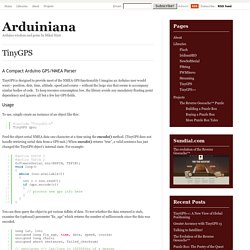
To keep resource consumption low, the library avoids any mandatory floating point dependency and ignores all but a few key GPS fields. Usage To use, simply create an instance of an object like this: Feed the object serial NMEA data one character at a time using the encode() method. You can then query the object to get various tidbits of data. Statistics The stats method provides a clue whether you are getting good data or not. Chars – the number of characters fed to the objectsentences – the number of valid $GPGGA and $GPRMC sentences processedfailed_checksum – the number of sentences that failed the checksum test Integral values Values returned by the core TinyGPS methods are integral. Current Limit Circuit for Voltage Regulator - Technical Forums. This is a low cost circuit that adds precise current limit functionality to a voltage regulator.
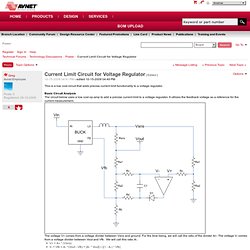
Basic Circuit Analysis The circuit below uses a low cost op-amp to add a precise current limit to a voltage regulator. It utilizes the feedback voltage as a reference for the current measurement. The voltage V+ comes from a voltage divider between Vsns and ground. For the time being, we will call the ratio of the divider A+. Secret Arduino Voltmeter – Measure Battery Voltage. A little known feature of Arduinos and many other AVR chips is the ability to measure the internal 1.1 volt reference.
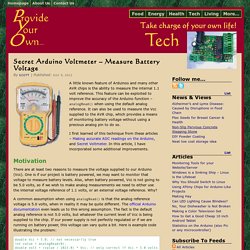
This feature can be exploited to improve the accuracy of the Arduino function – analogRead() when using the default analog reference. It can also be used to measure the Vcc supplied to the AVR chip, which provides a means of monitoring battery voltage without using a precious analog pin to do so. I first learned of this technique from these articles – Making accurate ADC readings on the Arduino, and Secret Voltmeter. In this article, I have incorporated some additional improvements. Reading out multiple buttons with a single ADC pin. To make things even more complicated, there is probably no way around that you will need to do some debouncing of the switch, just like it was digital input.
It takes, depending on the microprocessor, approximately up to 30 uS to make an analog conversion In this example taken from this excelent article by Ganssle ( it can take up to 150 uS before the switch deactivate (or activate). So depending on when you program makes the convertion it might not be the right value (read: pressed switch) unless you read multiple times over several mS until you get values within acceptable ranges/zones. This goes for both activating and deactivating. Robot Force Sensors, Robot Pressure Sensor, Robot Touch Sensor, FSR, Force sensing Resistor. Tactile Sensors. Touch and tactile sensor are devices which measures the parameters of a contact between the sensor and an object.
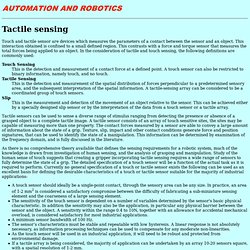
This interaction obtained is confined to a small defined region. This contrasts with a force and torque sensor that measures the total forces being applied to an object. In the consideration of tactile and touch sensing, the following definitions are commonly used: Touch Sensing. Wheel Encoder Systems Budget Robotics - Robot Kits, robotics kits, robot parts, educational robots, amateur robots. EZ-Encoder Patterns - Make your own high-quality wheel encoders...for under $5 per wheel Finally, an easy and affordable encoder disc system for desktop robotics.

Wheel encoders keep your robot headed where it's supposed to be going. Here's how they work: Stripes or holes in a pattern attached to the motor or wheel are used to monitor speed and revolutions. Your robot's control program keeps track of the pattern, and adjusts motor output accordingly. The idea isn't terribly complicated, but commercial wheel encoders can be expensive, and homebrew can be unpolished and prone to error. Sensorarten - RN-Wissen. Welche Sensorarten gibt es Damit sich ein Roboter in seiner Umgebung bewegen kann, ohne an Hindernisse anzustoßen, und damit er ein Ziel finden und ansteuern kann, muß er irgendwie seine Umwelt "wahrnehmen".
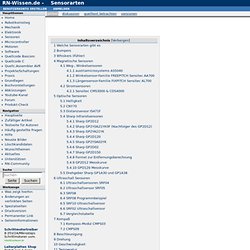
Hauptanwendung für diese Informationen aus der Umwelt ist die Navigation. Auf dieser Seite werden die wichtigsten Sensorarten und damit es praktischer wird auch zugleich die populärsten Robotik- und Modellbau-Sensortypen vorgestellt. Auch die Pinbelegung und Anschlussmöglichkeiten dieser Sensoren werden kurz erläutert. Es ist auch möglich Informationen für die Steuerung des Roboters nicht nur aus eigens dafür gebaute Sensoren zu gewinnen. Bumpers Als Bumpers bezeichnet man eine Art Stoßstange, die einen Mikro-Switch auslöst.
Die Auswertung erfolgt am besten digital an einem Pin mit Pull-up Widerstand. Laser Target Finder Sensor. Laser Target Finder Sensor I originally built this sensor to be able to perform triangulation navigation.
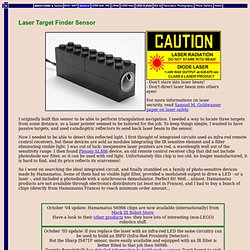
I needed a way to locate three targets from some distance, so a laser pointer seemed to be tailored for the job. To keep things simple, I wanted to have passive targets, and used catadioptric reflectors to send back laser beam to the sensor. Now I needed to be able to detect this reflected light. I first thought of integrated circuits used as infra-red remote control receivers, but these devices are sold as modules integrating the IR sensitive element and a filter eliminating visible light.
So I went on searching the ideal integrated circuit, and finally stumbled on a family of photo-sensitive devices made by Hamamatsu. The first purpose for building this sensor is not yet fulfilled... triangulation navigation requires fairly sophisticated software that I have not yet written: as I often say, my favorite programming language is the soldering iron! Circuit analysis Component selection.
Arduino Current Sensor. This Arduino based current, voltage, and power sensor/meter tutorial was created for hacktronics by Steve Spence. For my off-grid Ham Radio and Solar projects, I needed a way to measure volts, amps, watts, amp hours and watt hours. There's a couple of commercial products that can do this, but not with the flexibility I wanted. I designed a Arduino micro-controller based solution that is very extensible. Right now it monitors the above values of attached gear, and I'm thinking about adding web monitoring and a sd card for data collection.
Well, let's get started. Bumpers - PiE Wiki.